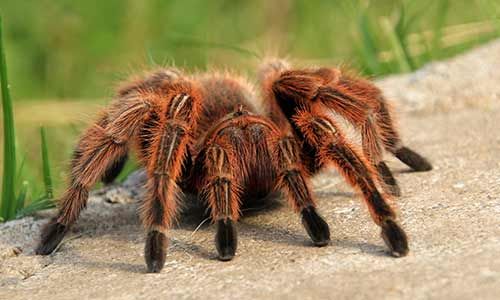Chilean rosy-haired tarantula
Grammostola rosea
You Can Find This Animal in the Bird's World
Fun Fact
Tarantulas get almost all of their moisture from the foods that they eat and can go for long periods of time--even months--without eating!

Class: Arachnida
Order: Araneae
Family: Theraphosidae
Genus: Grammostola
Species: rosea
Chilean rose hair tarantulas are a light-colored spider covered with hairs like most tarantulas. When threatened, these spiders will often use their legs to kick irritating hairs off of their abdomens. They live in burrows in a desert and scrub region in southern South America.
Size:
5 – 6 inch leg-span
Diet:
Small invertebrates: grasshoppers, crickets, cockroaches, beetles and moths.
Mating/Reproduction:
A mature male tarantula will approach the female’s burrow with caution, tapping and vibrating his legs to draw her out. If the female is receptive, she will allow him to mate with her. In the weeks following fertilization, the female produces a large egg sac, which usually contains around 500 spiderlings.
Behavior:
These fairly docile tarantulas don't move often and prefer to spend most of their time in burrows in the wild. When disturbed, the Chilean rose will usually run away or use its legs to kick off spine-like urticating hairs from its abdomen. These hairs are irritating and deter predators. As a last resort, the tarantula will use its fangs to issue a defensive bite.
Habitat/Range:
Includes the desert and scrub regions of northern Chile, Bolivia and Argentina.
Life Expectancy:
Males are relatively short-lived and often don’t live past 2 – 3 years, dying after reproduction. Females can live 15 – 20 years, or possibly longer.
Threats in Wild:
As their conservation status is unknown, threats are also unknown. It's possible to speculate that the wild population could be impacted by the pet trade, as the Chilean rose tarantula is one of the most common tarantulas in the pet trade.
Tarantulas get almost all of their moisture from the foods that they eat and can go for long periods of time--even months--without eating!
At Franklin Park Zoo:
At Stone Zoo:

